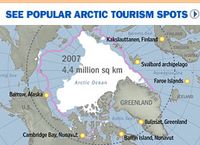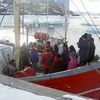3.10.2007 | 17:05
Toppurinn į tilverunni sķfellt vinsęlli fyrir hverfulleika
 Mér barst póstur frį Miriam Geitz vinkonu minni. Hśn sendi mér grein śr Wall Street Journal um hvernig feršamennska er aš breytast į noršurhveli og sķfellt fleiri feršamenn lašast aš feršalögum noršur um slóšir (og į Sušurskautslandiš) fyrir žęr sakir aš žar gętir meiri hverfulleika ķ nįttśrufari vegna żktari loftslagsbreytinga en annars stašar. Greinin er aš mörgu leyti įhugaverš, en žar gętir lķka svolķtillar "sensation" umfjöllunar um Ilullisat į Gręnlandi. Ég held aš greinarhöfundar hafi į réttu aš standa aš hverfulleiki jöklanna lašar aš og viš höfum fyrir žvķ vissu į sķšustu įrum. En ašeins er um stutt tķmabil į įri aš ręša žar sem sżnileiki brįšnunar er svona hrašur. Eins og Einar Sveinbjörnsson benti réttilega į er aukin ašgengileiki um hafiš noršan viš Gręnland/sjóleišin ašeins opin mjög skamman tķma įrs. Į öšrum tķmum įrs eru vešur óśtreiknanleg.
Mér barst póstur frį Miriam Geitz vinkonu minni. Hśn sendi mér grein śr Wall Street Journal um hvernig feršamennska er aš breytast į noršurhveli og sķfellt fleiri feršamenn lašast aš feršalögum noršur um slóšir (og į Sušurskautslandiš) fyrir žęr sakir aš žar gętir meiri hverfulleika ķ nįttśrufari vegna żktari loftslagsbreytinga en annars stašar. Greinin er aš mörgu leyti įhugaverš, en žar gętir lķka svolķtillar "sensation" umfjöllunar um Ilullisat į Gręnlandi. Ég held aš greinarhöfundar hafi į réttu aš standa aš hverfulleiki jöklanna lašar aš og viš höfum fyrir žvķ vissu į sķšustu įrum. En ašeins er um stutt tķmabil į įri aš ręša žar sem sżnileiki brįšnunar er svona hrašur. Eins og Einar Sveinbjörnsson benti réttilega į er aukin ašgengileiki um hafiš noršan viš Gręnland/sjóleišin ašeins opin mjög skamman tķma įrs. Į öšrum tķmum įrs eru vešur óśtreiknanleg.
Arctic Becomes Tourism Hot Spot, But Is That Cool?
Interest in Global Warming Is Now a Selling Point; Seeing Glaciers 'Calve'
By GAUTAM NAIK
September 24, 2007; Page A1
DISKO BAY, Greenland -- James Brusslan is an environmental lawyer with climate
change on his mind. He cycles to the office and works at a Chicago law firm that
offsets its carbon emissions. He plasters friends' SUVs with stickers that say: "I'm
changing the climate! Ask me how!"
<http://online.wsj.com/public/resources/documents/info-arctictourism0709.html>
To get a first-hand glimpse of such changes, Mr. Brusslan, 50 years old, recently
spent $2,800 on a week's camping trip here, about 200 miles north of the Arctic
Circle. "I wanted to see what was happening," he said, as he gazed at an ice fiord
where a glacier was splintering into icebergs. "In 10 years, it probably will be
gone." He next plans to see the melting glaciers of Sichuan, China.
Global warming has given rise to a new niche in the booming eco-tourism business:
climate tourists. These visitors seek out places where a long-term warming trend --
subject of a global summit hosted by the United Nations this week -- is starting to
have a discernible impact. Yet some say there's a big irony in this kind of travel:
Any trip by train, plane or cruise ship pumps carbon dioxide into the atmosphere and
potentially contributes to the warming of the planet.
"What's the point of your trip to the Maldives if the end result is that it will be
drowned" because emissions from eco-tourists' jets contribute to global warming and
rising seas, says Jeff Gazzard of Aviation Environmental Federation, a United
Kingdom group fighting to curtail airplane emissions. The Maldives, a string of
islands in the Indian Ocean, sit about three feet above sea level and are at risk if
warming effects raise ocean levels.
More than 1.5 million tourists now visit the arctic each year, up from one million
in the early 1990s, according to the U.N. Longer and warmer summers keep arctic seas
freer of ice flows, so cruise ships can visit places that were once inaccessible --
raising other environmental concerns.
Some tourists to Norway's Svalbard archipelago in the arctic hope to catch sight of
new islands that have appeared as the ice sheet retreats. "They're just rocks,"
scoffs Rune Bergstroem, head of the environment department at the governor of
Svalbard's office. That didn't stop a recent visitor from England from trying to
claim one such island, going ashore and writing his bid on a baked-bean can. It was
rejected.
The annual number of visitors to Svalbard has surged 33% in the past five years to
about 80,000. About half arrive on cruise liners. With so many more passengers going
ashore, fragile vegetation on some islands has gotten worn down. There's a higher
risk of an oil spill; a new law requires ships on the eastern part of the islands to
use marine diesel instead of heavy oil.
Local wildlife is under threat, and not just from direct climate change. "Regions
with polar bears were hard to access, but boats can now get there because the sea
ice melts," says Mr. Bergstroem. "There could be more conflicts between people and
bears."
<http://online.wsj.com/article/SB118952521979723889.html>
Still, global warming can be a persuasive sales pitch. This month, Betchart
Expeditions Inc., of Cupertino, Calif., offers a 12-day voyage to "Warming Island"
near Greenland. Melting ice has revealed the long-buried island, "a compelling
indicator of the rapid speed of global warming," says Betchart's Web site. The cost:
between $5,000 and $7,000, not including flights. So far, 38 people have signed up.
Earthwatch Institute, a nonprofit in Maynard, Mass., runs trips that allow people to
help scientists studying coral reefs in the Bahamas and the effects of climate
change on orchids in India. Its 11-day trip, "Climate Change at the Arctic's Edge"
-- priced between $2,849 and $4,349, not including flights -- involves going to
Manitoba, Canada, to monitor carbon stores in the permafrost.
Hansruedi Burgener didn't seek out climate tourists -- they found him. Last summer,
hundreds trekked to his remote hostel-cum-restaurant in the Swiss Alps, because it
has a clear view of a mountain called the Eiger. Noting that a warming trend had
accelerated melting of glacial ice, geologists predicted part of the mountain would
soon collapse. To mark the event, Mr. Burgener introduced a coffee-and-schnapps
concoction called a "Rockslide."
In July 2006, about a half-million cubic meters of the Eiger -- the volume of a
small skyscraper -- plunged into the valley. No one was hurt, but dust from the
impact blanketed the nearby resort of Grindelwald. Tourists still go there, to see
where the rock fall occurred. "I don't think climate change is good for the
environment," says Mr. Burgener. "But it's made the hostel famous, and that's good
for me."
There are some efforts to keep the trend from heating up. The International
Ecotourism Society, based in Washington, D.C., launched a campaign called "Traveling
with Climate in Mind" to help people "minimize their environmental footprint"
through better use of energy and offsetting emissions.
In March, the airline SAS started a program that allows passengers to pay a fee --
up to €8 for a European flight -- to offset their flight-related emissions. The
money is spent on a renewable-energy project. But though the airline carries more
than four million passengers a month, it has registered only about 600 transactions
so far.
"It's low; we're disappointed," says Neils Ierek Nertun, environmental director for
SAS.
Per Stuhaug, a 53-year-old consultant for International Business Machines Corp. in
Copenhagen, took a recent SAS flight to visit Greenland's vast inland ice sheet. He
said he was "interested in seeing any changes since my last visit," a 2004 camping
trip. But he dismissed the airline's carbon-offset program as a marketing gimmick
and didn't pay the fee.
Though they are hardly the main contributor to global warming, tourists interested
in climate change recognize a dilemma. "I have a curiosity about these places, but
going there to see them causes more damage," says Anne Patrick, a Massachusetts
schoolteacher who has visited Antarctica and Greenland. "How do you come to grips
with that? I don't have an answer."
Most visitors to Greenland head to the town of Ilulissat, a settlement of brightly
painted houses with a breathtaking view of icebergs. Scientists speculate that the
iceberg that sank the Titanic originated here.
Ilulissat has become a poster child for global warming. January temperatures used to
routinely hit minus 40 degrees Fahrenheit, but now rarely fall below minus 13
Fahrenheit. The nearest glacier, Jacobshavn, has retreated more than nine miles
since 2002. The bay no longer freezes, so fishermen catch halibut all year long,
depleting stocks, says Konrad Seblon, district manager of a provincial agency
charged with developing tourism.
This year, the town has hosted Nancy Pelosi, speaker of the U.S. House of
Representatives, Barbara Boxer, U.S. senator from California, and the president of
the European Union. Up to 35,000 tourists are expected too, compared with 10,000
some five years ago. The town's population is 5,000 people and a lot more sled
dogs.
"Tourists are welcome, but we don't want too many. And we don't want big hotels,"
says Anthon Frederiksen, Ilulissat's mayor. "We'd like to preserve nature and our
culture."
Many visitors shell out $300 for a trip to a glacier called Eqi. When Eqi reaches
the sea, large pieces "calve," or break off, becoming icebergs. One recent
afternoon, a boat filled with tourists drew near Eqi's 250-foot-tall ice face.
Suddenly, a chunk the size of a small house plunged into the waters, unleashing a
6-foot swell.
The wave slammed into the boat, rocking it hard. "That was exciting," said Ingeborg
Mathiesen, a 68-year-old Norwegian, as she gripped the guard rails. "I've never seen
anything like it."
The day before, a similar wave in Svalbard pounded a sightseeing boat and injured 17
British tourists. Next summer, Ms. Mathiesen plans to visit Svalbard, to see
icebergs and polar bears. Says her husband, Erich: "We don't want to wait five years
when they may be gone."
Write to Gautam Naik at gautam.naik@wsj.com5
URL for this article:
http://online.wsj.com/article/SB119040811877635606.html
Hyperlinks in this Article:
(1)
OpenWin('http://online.wsj.com/public/resources/documents/info-flash07.html?project=arctictourism0709&h=490&w=950&hasAd=1&settings=arctictourism0709','arctictourism0709','950','660','off','true',40,10);return
(3)
http://online.wsj.com/public/article_print/OpenWin%28%
(4)
http://online.wsj.com/public/resources/documents/info-flash07.html?project=arctictourism0709&h=490&w=950&hasAd=1&settings=arctictourism0709','arctictourism0709','950','660','off','true',40,10);return
(5) mailto:gautam.naik@wsj.com
Meginflokkur: Feršalög | Aukaflokkar: Lķfstķll, Stjórnmįl og samfélag, Vķsindi og fręši | Breytt s.d. kl. 17:41 | Facebook


 aloevera
aloevera
 apalsson
apalsson
 axelthor
axelthor
 arnid
arnid
 begga
begga
 birgitta
birgitta
 bjarnimax
bjarnimax
 gattin
gattin
 dofri
dofri
 patent
patent
 killjoker
killjoker
 neytendatalsmadur
neytendatalsmadur
 lucas
lucas
 gudr
gudr
 gudrunvala
gudrunvala
 hrannarb
hrannarb
 ingibjorgelsa
ingibjorgelsa
 ingolfurasgeirjohannesson
ingolfurasgeirjohannesson
 kreppan
kreppan
 jon-o-vilhjalmsson
jon-o-vilhjalmsson
 hugsadu
hugsadu
 larahanna
larahanna
 manisvans
manisvans
 mixa
mixa
 methusalem
methusalem
 mortenl
mortenl
 olijon
olijon
 salvor
salvor
 sigurborgkrhannesdottir
sigurborgkrhannesdottir
 siggi-hrellir
siggi-hrellir
 shv
shv
 steina
steina
 torfusamtokin
torfusamtokin
 toshiki
toshiki
 valgeirskagfjord
valgeirskagfjord
 vefritid
vefritid
 vilberg
vilberg
 villidenni
villidenni
 postdoc
postdoc
 thorrialmennings
thorrialmennings





Bęta viš athugasemd [Innskrįning]
Ekki er lengur hęgt aš skrifa athugasemdir viš fęrsluna, žar sem tķmamörk į athugasemdir eru lišin.